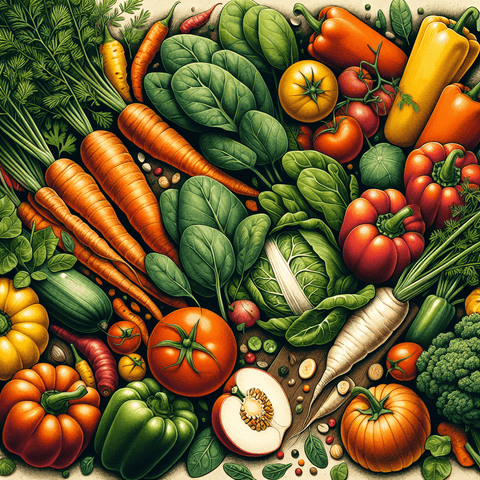Introduction
Vitamin A is a vital micronutrient required for numerous bodily functions, including vision, immune response, reproduction, and cellular communication. Especially known for its role in eye health, vitamin A also plays a key part in the maintenance of heart, lungs, and kidney functionality. While supplements can offer concentrated forms of this nutrient, diet remains one of the most effective and natural ways to ensure adequate intake.
With rising attention on plant-based nutrition, vegetables have taken center stage in the conversation about optimal wellness. Plant-sourced vitamin A comes primarily in the form of provitamin A carotenoids—especially beta-carotene—which the body converts into the active form of vitamin A as needed. Understanding which vegetables offer the highest vitamin A content is not only crucial for dietary planning but also for supplement manufacturers and health practitioners aiming to guide balanced nutrient intake.
This article explores in detail which vegetables are richest in vitamin A, how they compare when measured against supplements, factors affecting absorption, and how best to integrate them into a daily health regimen. Whether you're a health-conscious individual, a vegetarian, or someone exploring nutrition-focused supplements, this comprehensive guide will help you maximize your vitamin A intake through informed choices.
1. Vegetables Rich in Vitamin A: A Nutritional Supplement Perspective
From a supplemental perspective, vegetables serve a dual role: as direct dietary sources and as raw materials in the formulation of plant-based vitamin A supplements. Certain vegetables are powerhouse sources of beta-carotene and other carotenoids, the precursors to active vitamin A (retinol). Understanding their nutrient density is critical both for personal dietary choices and for the development of high-quality nutritional products.
Top vegetables recognized for their rich vitamin A profiles include leafy greens, root vegetables, squashes, and some vibrantly colored fruits often botanically classified as vegetables. Spinach, for example, offers upwards of 9,000 IU of vitamin A per cooked cup, while carrots provide around 10,000 IU per cooked cup—more than twice the recommended daily intake. These values highlight the immense potential of vegetables in fulfilling vitamin A requirements naturally.
In the context of nutritional supplements, vegetables high in provitamin A provide a sustainable and plant-based avenue for vitamin A capture. Supplement manufacturers often extract beta-carotene from sources like dunaliella salina (a type of algae), but beta-carotene can also be popularly derived from carrot concentrate and other vegetable extracts. These formulations are particularly appealing to vegetarians and individuals pursuing natural supplementation strategies.
For individuals focusing on boosting their vitamin A from food before turning to supplements, incorporating a variety of these vegetables ensures not just better overall intake of vitamin A, but also other synergistic nutrients like fiber, antioxidants, and minerals. Nonetheless, when dietary intake is insufficient—due to medical conditions, restricted diets, or poor absorption—supplementing with vitamin A remains a valuable strategy. Our collection of vitamin D, K, and beta-carotene-rich omega supplements further complements your nutritional toolkit.
2. Leafy Green Vegetables, Beta-Carotene Sources, Vitamin A-Rich Root Vegetables, Colorful Vegetables for Vitamin A, Plant-Based Vitamin A Sources
Understanding Leafy Green Vegetables as Vitamin A Powerhouses
Leafy green vegetables are nutritional titans, especially when it comes to vitamins and minerals. Among their many benefits, they offer exceptional levels of vitamin A in the form of beta-carotene. Spinach tops the list with an impressive 9,377 IU per cooked cup. Kale isn't far behind, delivering with more than 17,700 IU of provitamin A, while Swiss chard and collard greens also contribute large amounts of beta-carotene.
The incorporation of these greens into daily meals is straightforward—smoothies, sautés, salads, and soups offer many opportunities to increase intake. From a nutritional supplements perspective, leafy greens are often foundational ingredients in superfood blends and whole-food powder formulas aimed at delivering comprehensive micronutrient profiles.
One of the key factors in maximizing vitamin A benefits from greens is preparation. Cooking leafy greens breaks down plant cell walls, enhancing the bioavailability of beta-carotene. Furthermore, consuming them with healthy fats (like olive oil or avocados) enhances fat-soluble vitamin absorption. This means a spinach salad with olive oil dressing is not just delicious—it’s a smart move for nutrient absorption.
These vegetables also align with supplement needs, offering natural compounds without synthetic additives. For those with limited access to fresh vegetables, powdered greens or blended multivitamin options offer concentrated forms of these leafy green nutrients. Make sure to check our vitamin K collection, which pairs naturally with leafy greens for bone and blood health support.
Beta-Carotene Sources: The Bright Color Connection
Beta-carotene is the most acclaimed of the provitamin A carotenoids. Its presence in vegetables is typically signaled by vibrant shades of orange, yellow, and red—often dubbed “the bright color connection.” Carrots are the most well-known example, boasting up to 10,692 IU of vitamin A per 100g when cooked. Sweet potatoes offer an even more impressive figure, with a single medium baked sweet potato delivering over 21,000 IU—far exceeding daily requirements.
The appeal of beta-carotene-rich vegetables extends beyond just vitamin A content. These vegetables also contain complex phytonutrients and antioxidants, contributing to their roles in longevity and wellness. They are frequently targeted for incorporation into vitamin A supplements due to their natural origin, stability, and recognized safety profile.
Another crucial aspect of beta-carotene is the body's self-regulating mechanism. Unlike preformed vitamin A (retinol), beta-carotene is converted only as needed, reducing the risk of hypervitaminosis A. This makes beta-carotene-rich vegetables a safer and more effective long-term strategy for vitamin A intake, especially for individuals relying on plant-based diets.
For supplement manufacturers and consumers alike, the high stability and availability of beta-carotene-rich extracts from vegetables such as carrots and squashes are ideal. These sources complement our high-quality offerings in categories like omega-3 DHA and EPA-rich supplements, which support comprehensive eye health alongside vitamin A’s benefits.
Vitamin A-Rich Root Vegetables: Deep-Dive into Underappreciated Gems
While carrots often steal the spotlight, other root vegetables like parsnips, beets (greens), and rutabagas also offer meaningful levels of vitamin A. Parsnips, for example, provide around 1,500 IU per standard serving, primarily as beta-carotene. Importantly, the preparation of such roots makes a significant difference—steaming and roasting not only enhance taste but also improve digestibility and nutrient bioavailability.
The deeper the color of the root vegetable, the higher its carotenoid concentration. Therefore, selecting richly pigmented varieties gives a nutritional edge. Beets offer minimal vitamin A in their root form, but their leafy greens are replete with beta-carotene and other carotenoids. One cup of cooked beet greens yields over 2,900 IU of vitamin A.
These underappreciated root vegetables can easily be incorporated into soups, stews, mashed dishes, or baked recipes, making them both functional and flavorful additions to meals. They're also more shelf-stable than leafy greens, offering a practical option for long-term storage and inclusion in powdered vegetable blends in supplements.
When manufactured into concentrates or extracts, these roots provide a balanced mix of vitamin A precursors and support compounds. Moreover, their antioxidant capacity fits perfectly within a supplemental profile aimed at supporting immune and skin health in combination with other vitamins like C. Be sure to browse our collection of vitamin C immune-support supplements for synergistic solutions.
Colorful Vegetables for Vitamin A: The Power of Pigments
The concentration of beta-carotene in vegetables is closely linked to their coloration. Vibrantly pigmented foods such as red bell peppers, tomatoes, pumpkins, and butternut squash are all rich rectangles on the vitamin A board. Beyond aesthetics, those colors represent a substantial antioxidant and phytochemical advantage.
Pumpkin ranks among the highest with more than 7,500 IU per cooked cup. Butternut squash provides over 11,000 IU per serving. Red peppers contain less beta-carotene than darker orange vegetables, but still contribute meaningfully—around 3,000 IU per cup when raw. What's more, they are also rich in vitamin C, which adds to their immune-support credentials and synergizes with vitamin A’s role in maintaining mucosal integrity against pathogens.
Don’t forget tomatoes—while not as rich in vitamin A as others on this list, they offer lycopene, another carotenoid that supports skin and cardiovascular health. When consumed in combination, these colorful vegetables amplify nutritional effects through the spectrum of antioxidants they offer.
In supplements, color-rich vegetables are often used in whole-food complexes and multivitamin capsules. Their extracts retain more than just vitamin A precursors—they deliver a cocktail of health-promoting compounds. Energy smoothies, vegetable powders, and superfood blends sold through reputable platforms like Topvitamine.com make these vegetables even more convenient to consume regularly for people with demanding schedules.
Plant-Based Vitamin A Sources: Top Vegetables for a Holistic Approach
When taking a holistic approach to vitamin A, relying solely on a single vegetable isn't as effective as drawing from a range of sources. This strategy is particularly important for vegetarians and vegans, whose intake depends entirely on provitamin A carotenoids, as they do not consume retinol from animal products.
Top contenders for plant-based vitamin A content remain sweet potatoes, carrots, spinach, kale, and butternut squash. Combining these with other lesser-known sources like beet greens, parsley, cilantro, red bell peppers, and mustard greens results in a dietary mosaic rich in carotenoids, fiber, and essential vitamins.
Supplements tailored for plant-based lifestyles often include blends of multiple vegetables to guarantee both variety and balance. Fortunately, these supplements avoid the use of synthetic retinol, mitigating overdose risk while supporting sustainable agriculture. They also align well with ethical and environmental goals shared by many health-conscious consumers.
Individuals with higher susceptibility to nutrient deficiencies, such as elderly individuals or those with malabsorption syndromes, may benefit from daily intake of plant-based vitamin A supplements formulated with concentrated vegetable extracts. The strategic use of both fresh vegetables and nutritional support ensures a comprehensive vitamin A strategy accessible to everyone, regardless of dietary constraints.
3. Comparing the Vitamin A Content: Vegetables vs. Supplements
When evaluating vitamin A consumption, it is helpful to compare the content provided by vegetables with that of popular supplements. One medium sweet potato offers approximately 21,900 IU of vitamin A in the form of beta-carotene. Meanwhile, standard dietary supplements can deliver between 2,500 IU and 10,000 IU per dose, usually in the form of retinyl palmitate or beta-carotene.
The major difference lies in bioavailability and absorption. Retinol in supplements is more readily absorbed but comes with an increased risk of toxicity at high doses. Beta-carotene, the vegetable-derived compound, offers a safer alternative due to its regulated conversion in the intestine. EFSA considers an acceptable daily intake (ADI) for beta-carotene to be up to 15 mg/day, making vegetables a safe source for regular consumption.
Ultimately, a balanced approach that incorporates vegetables into a daily diet while also leveraging supplements when necessary provides flexibility and security. Those who are deficient or unable to absorb carotenoids efficiently—due to genetic polymorphisms or health conditions—may benefit from specific formulations available through our nutritional support categories.
4. Factors Affecting Vitamin A Absorption and Conversion from Vegetables
Several variables influence the absorption and conversion of plant-based beta-carotene to active vitamin A. Cooking is one such critical factor. Light steaming or roasting breaks down cell walls, significantly enhancing beta-carotene's bioavailability. Raw versions, while healthy, offer lower absorption rates.
Dietary fat also plays an indispensable role. Being fat-soluble, vitamin A benefits from the presence of oils and fats in meals. Pairing vegetables with healthy fats like olive oil, nuts, or seeds boosts carotenoid absorption. For example, a spinach salad with a tahini dressing not only tastes great but improves vitamin A uptake synergistically.
Individual health status and genetics also affect beta-carotene conversion. An individual's age, digestion efficacy, and even alcohol consumption levels can all modulate vitamin A conversion rates. This is where supplements serve as reliable backups. Personalized nutrition plans that combine food sources with targeted supplements create a safety net against inadequacies and conversion inefficiency.
5. Choosing the Right Vegetable or Supplement to Meet Your Vitamin A Needs
For most individuals, starting with a diet rich in vegetables will adequately meet their vitamin A needs. Daily inclusion of foods like carrots, kale, spinach, sweet potato, and pumpkin, in various forms and meal types, yields excellent results. Complementing these vegetables with healthy fats is essential to ensure efficient uptake.
However, there are moments where supplements become necessary. These include cases of documented deficiency, certain lipid absorption disorders, or restricted diets. In such scenarios, high-quality vitamin A supplementation, preferably from natural beta-carotene sources, offers a solution. We recommend exploring our customized blends available in the Vitamin D & A synergy supplement section.
6. Final Thoughts: Maximizing Vitamin A Intake for Better Health
Vitamin A is essential for numerous bodily functions, from vision and immunity to reproduction and cellular health. Prioritizing whole, plant-based foods offers a balanced and safe method to meet vitamin A requirements, minimizing the risk of toxicity associated with synthetic retinol-based supplements.
The best strategy involves a combination of high-vitamin A vegetables, healthy fats, and select nutritional support supplements when necessary. Especially for populations with specific dietary constraints or medical needs, supplements play a vital support role.
Always consider personal health status and consult a healthcare provider before making major dietary or supplement changes. At Topvitamine.com, we offer the highest-quality curated nutritional supplements that complement your vegetable-forward lifestyle for optimal vitamin A and overall health intake.
Conclusion
In summary, the vegetables richest in vitamin A include sweet potatoes, carrots, spinach, kale, Swiss chard, butternut squash, and red bell peppers. These plant-based sources provide substantial amounts of beta-carotene—the safe and efficient precursor to vitamin A.
Leveraging a wide variety of colorful vegetables in your diet ensures not only vitamin A sufficiency but also a spectrum of other valuable nutrients. For additional support or in cases of elevated need, trusted supplements from Topvitamine.com offer a natural, complementing solution.
Take proactive steps today. Start by exploring our vegetable-based recipes and premium-quality supplements to ensure your vitamin A regimen is as vibrant and effective as the vegetables you consume.
Q&A Section
Q: What vegetable has the highest amount of vitamin A?
A: Sweet potatoes deliver the most vitamin A per serving, offering around 21,900 IU in a medium-sized baked potato.
Q: Is plant-based vitamin A as effective as synthetic supplements?
A: Yes, especially when consumed with fats and cooked properly. Beta-carotene from vegetables is converted into vitamin A as the body needs it, which also reduces the risk of toxicity.
Q: Should I cook vegetables to improve vitamin A absorption?
A: Yes. Cooking—such as steaming or roasting—helps break down plant cell walls and improves beta-carotene bioavailability, especially when consumed with healthy fats.
Q: How can I know if I need a supplement?
A: Individuals with medical conditions, restricted diets, or absorption issues may benefit from supplements. For general wellness, diet-based intake is usually sufficient. Consult a healthcare professional for personalized advice.
Q: Are there any risks in taking too much vitamin A?
A: Yes. Excessive intake of synthetic retinol can cause toxicity. Beta-carotene from vegetables is safer, as the body regulates its conversion. Always follow recommended dosages when using supplements.
Important Keywords
Vitamin A vegetables, beta-carotene vegetables, high vitamin A foods, plant-based vitamin A, leafy greens nutrition, supplements vitamin A, vitamin A rich vegetables, sweet potato vitamin A, carrots beta-carotene, Topvitamine vitamin A supplements, vegetable vitamin A sources.



